Abstract
AIM: To determine the prevalence of cerebral palsy in a specific population. METHODS: Multiple sources of ascertainment were used to create and maintain a register of all cases of cerebral palsy born to mothers resident in the counties of Merseyside and Cheshire in the years 1966 to 1989. Denominator data of infant births and deaths from 1966 to 1981 were obtained from statutory notifications made to health authorities and, for the period 1982-89, from statutory birth and death registrations. Over 1500 cases formed the database for the study. RESULTS: The prevalence of cerebral palsy has increased among all the low birthweight groups with, most recently, an increase in infants weighing < 1000 g at birth. Low birthweight infants now comprise about 50% of all cases of cerebral palsy; in the early years of the study they comprised about 32% of all cases. The proportion of cerebral palsy by clinical type has changed among low birthweight babies, with relatively fewer cases with diplegia and a concomitant increase in the proportion with hemiplegia. An increase in the severity of functional disability, determined by the proportion of children with severe learning, manual, and ambulatory disabilities, was also found. CONCLUSIONS: The change in the epidemiology of cerebral palsy has implications for the aetiology of the condition, and for health, educational, and social service provision.
Full text
PDF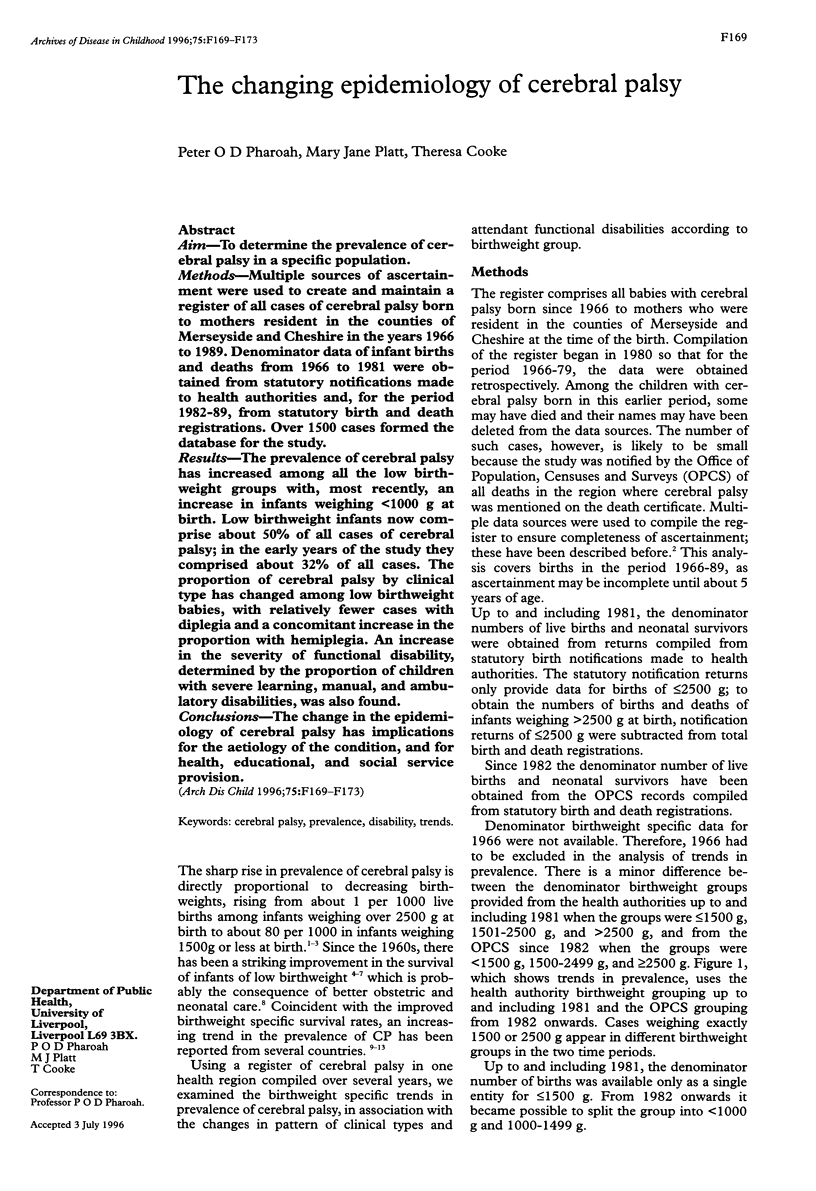
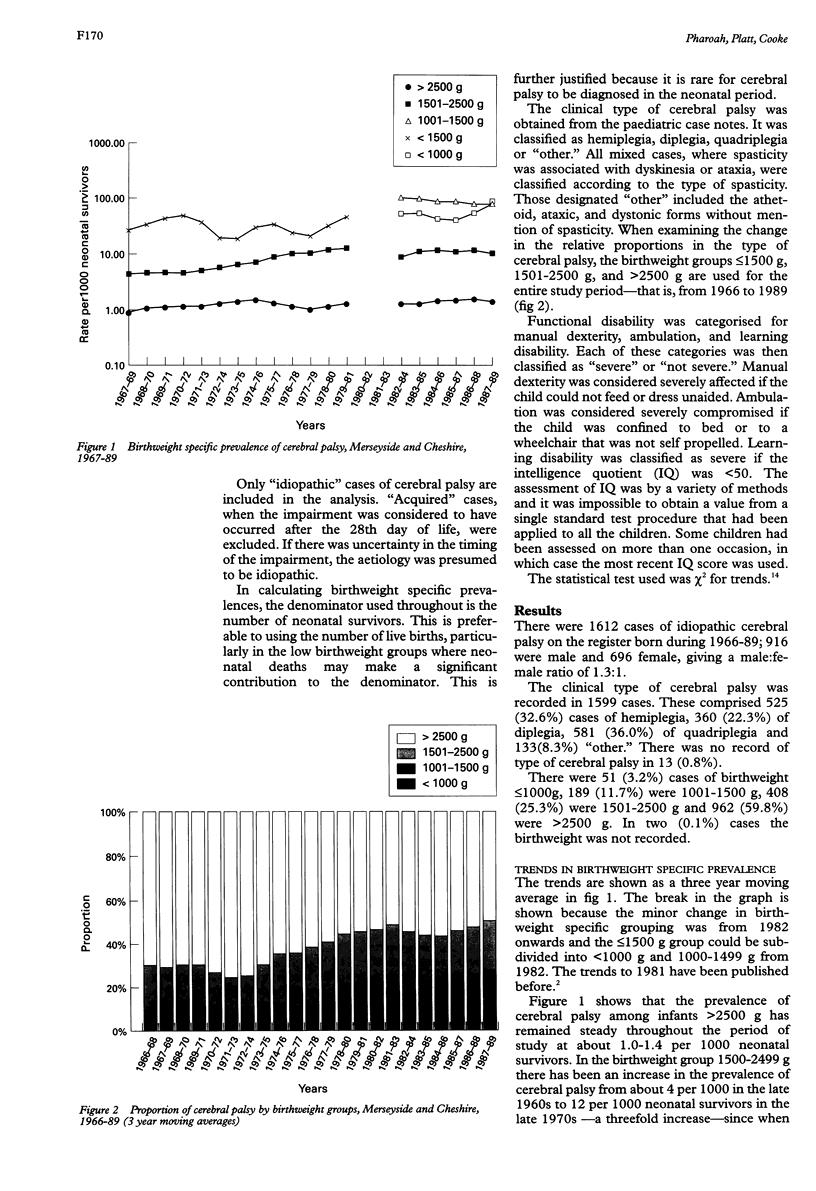
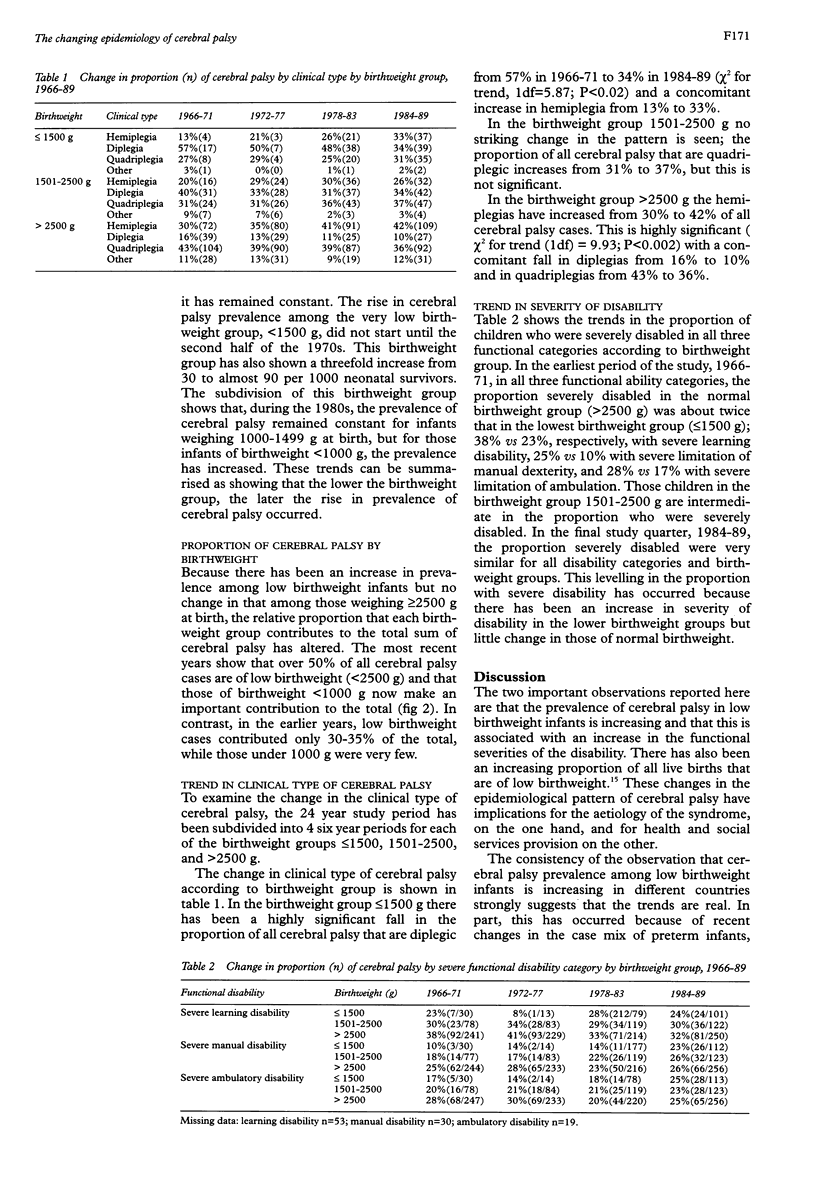
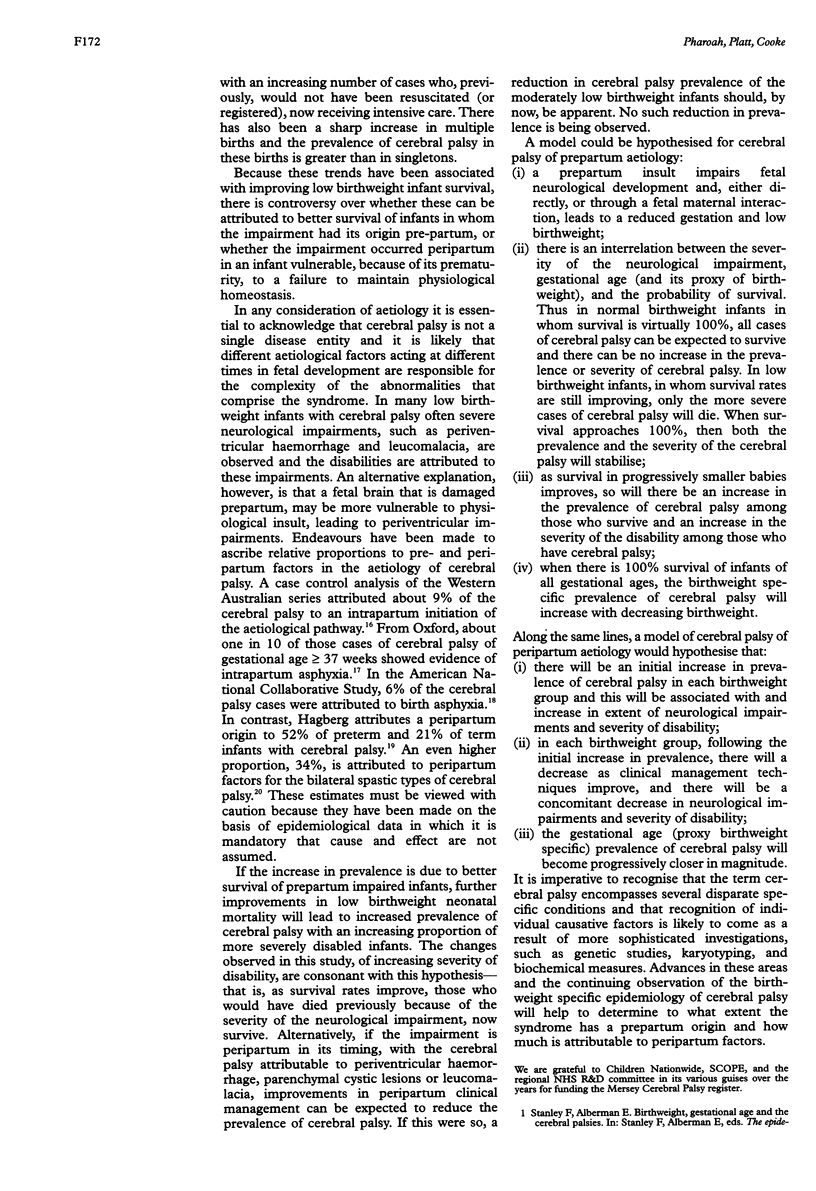
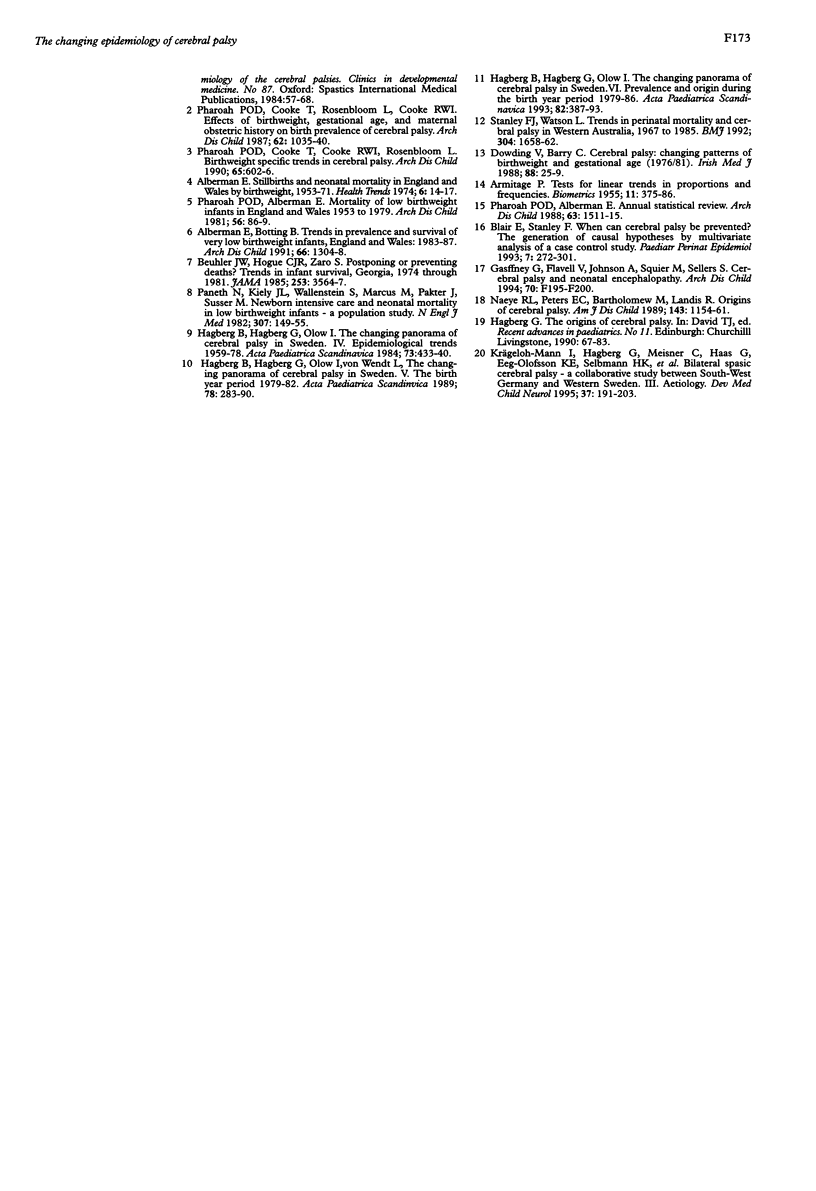
Selected References
These references are in PubMed. This may not be the complete list of references from this article.
- Alberman E., Botting B. Trends in prevalence and survival of very low birthweight infants, England and Wales: 1983-7. Arch Dis Child. 1991 Nov;66(11):1304–1308. doi: 10.1136/adc.66.11.1304. [DOI] [PMC free article] [PubMed] [Google Scholar]
- Blair E., Stanley F. When can cerebral palsy be prevented? The generation of causal hypotheses by multivariate analysis of a case-control study. Paediatr Perinat Epidemiol. 1993 Jul;7(3):272–301. doi: 10.1111/j.1365-3016.1993.tb00405.x. [DOI] [PubMed] [Google Scholar]
- Buehler J. W., Hogue C. J., Zaro S. M. Postponing or preventing deaths? Trends in infant survival, Georgia, 1974 through 1981. JAMA. 1985 Jun 28;253(24):3564–3567. doi: 10.1001/jama.253.24.3564. [DOI] [PubMed] [Google Scholar]
- Dowding V. M., Barry C. Cerebral palsy: changing patterns of birthweight and gestational age (1976/81). Ir Med J. 1988 Nov;81(1):25–29. [PubMed] [Google Scholar]
- Gaffney G., Flavell V., Johnson A., Squier M., Sellers S. Cerebral palsy and neonatal encephalopathy. Arch Dis Child Fetal Neonatal Ed. 1994 May;70(3):F195–F200. doi: 10.1136/fn.70.3.f195. [DOI] [PMC free article] [PubMed] [Google Scholar]
- Hagberg B., Hagberg G., Olow I. The changing panorama of cerebral palsy in Sweden. IV. Epidemiological trends 1959-78. Acta Paediatr Scand. 1984 Jul;73(4):433–440. doi: 10.1111/j.1651-2227.1984.tb09951.x. [DOI] [PubMed] [Google Scholar]
- Hagberg B., Hagberg G., Olow I. The changing panorama of cerebral palsy in Sweden. VI. Prevalence and origin during the birth year period 1983-1986. Acta Paediatr. 1993 Apr;82(4):387–393. doi: 10.1111/j.1651-2227.1993.tb12704.x. [DOI] [PubMed] [Google Scholar]
- Hagberg B., Hagberg G., Olow I., von Wendt L. The changing panorama of cerebral palsy in Sweden. V. The birth year period 1979-82. Acta Paediatr Scand. 1989 Mar;78(2):283–290. doi: 10.1111/j.1651-2227.1989.tb11071.x. [DOI] [PubMed] [Google Scholar]
- Krägeloh-Mann I., Hagberg G., Meisner C., Haas G., Eeg-Olofsson K. E., Selbmann H. K., Hagberg B., Michaelis R. Bilateral spastic cerebral palsy--a collaborative study between southwest Germany and western Sweden. III: Aetiology. Dev Med Child Neurol. 1995 Mar;37(3):191–203. doi: 10.1111/j.1469-8749.1995.tb11992.x. [DOI] [PubMed] [Google Scholar]
- Naeye R. L., Peters E. C., Bartholomew M., Landis J. R. Origins of cerebral palsy. Am J Dis Child. 1989 Oct;143(10):1154–1161. doi: 10.1001/archpedi.1989.02150220044018. [DOI] [PubMed] [Google Scholar]
- Paneth N., Kiely J. L., Wallenstein S., Marcus M., Pakter J., Susser M. Newborn intensive care and neonatal mortality in low-birth-weight infants: a population study. N Engl J Med. 1982 Jul 15;307(3):149–155. doi: 10.1056/NEJM198207153070303. [DOI] [PubMed] [Google Scholar]
- Pharoah P. O., Alberman E. D. Mortality of low birthweight infants in England and Wales 1953 to 1979. Arch Dis Child. 1981 Feb;56(2):86–89. doi: 10.1136/adc.56.2.86. [DOI] [PMC free article] [PubMed] [Google Scholar]
- Pharoah P. O., Alberman E. Annual statistical review. Arch Dis Child. 1988 Dec;63(12):1511–1515. doi: 10.1136/adc.63.12.1511. [DOI] [PMC free article] [PubMed] [Google Scholar]
- Pharoah P. O., Cooke T., Cooke R. W., Rosenbloom L. Birthweight specific trends in cerebral palsy. Arch Dis Child. 1990 Jun;65(6):602–606. doi: 10.1136/adc.65.6.602. [DOI] [PMC free article] [PubMed] [Google Scholar]
- Pharoah P. O., Cooke T., Rosenbloom L., Cooke R. W. Effects of birth weight, gestational age, and maternal obstetric history on birth prevalence of cerebral palsy. Arch Dis Child. 1987 Oct;62(10):1035–1040. doi: 10.1136/adc.62.10.1035. [DOI] [PMC free article] [PubMed] [Google Scholar]
- Stanley F. J., Watson L. Trends in perinatal mortality and cerebral palsy in Western Australia, 1967 to 1985. BMJ. 1992 Jun 27;304(6843):1658–1663. doi: 10.1136/bmj.304.6843.1658. [DOI] [PMC free article] [PubMed] [Google Scholar]


